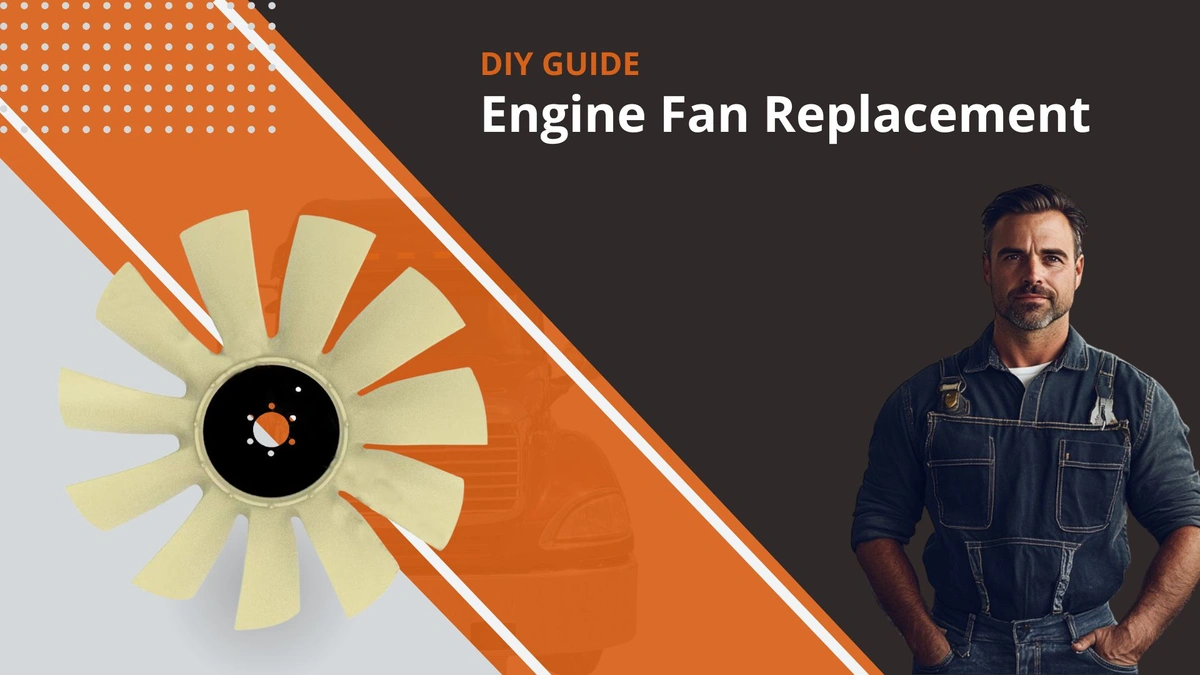Need help? We're here!
(888) 312-8812 Login SignupHow to Fix Your Truck's Engine Fan: A Step-by-Step Repair Guide
October 23, 2024

How to Fix Your Truck's Engine Fan: A Step-by-Step Repair Guide
If your truck's engine fan is staying on or not working correctly, it can lead to bigger issues like overheating and reduced engine performance. Whether you're a truck driver, fleet owner, or DIY enthusiast, this guide from DIY SEMI will help you troubleshoot and repair the issue yourself, saving you time and expensive repair costs. We’ll walk you through common causes, fixes, and tips for maintaining your engine’s cooling system.
Purpose of This Guide
This guide is designed for truck drivers, fleet owners, and DIYers who want to save money by fixing their truck’s engine fan instead of taking it to a repair shop. You'll learn how to troubleshoot and repair engine cooling fan issues to keep your truck running smoothly.
Tools Needed
Before you begin your engine fan repair, make sure you have these essential tools on hand:
-
Multimeter for electrical testing
-
Shop air compressor (optional for testing fan clutch)
-
Safety gloves and glasses
-
Replacement parts (fan clutch, solenoid, pressure switches, etc.)
Step-by-Step Instructions for Cooling Fan Troubleshooting
Step 1: Diagnose the Issue
The first step in cooling fan troubleshooting is to identify the problem. Common signs of engine fan failure include:
-
The fan remains stuck on and runs continuously.
-
The cooling fan is not working, leading to overheating.
-
Unusual noises coming from the fan area.
Start by turning the key to the "on" position, but leave the engine off. Build up air pressure and listen for air leaks around the fan clutch area. If you hear a hissing sound, you might have a leak that's preventing the fan from disengaging.
Step 2: Inspect the Fan Clutch and Solenoid
The fan clutch is responsible for engaging and disengaging the engine fan based on the truck's needs. Follow these steps for engine fan clutch repair:
-
Check for air leaks: If the fan clutch has an air leak, it may not disengage properly. Stick your head under the hood and listen for a hollow, whooshing sound. No sound? Move on to the next step.
-
Spin the fan blades by hand: With the truck off and the key on, you should be able to turn the fan blades by hand. If they're locked and won't spin, the fan clutch might be seized and in need of replacement.
-
Test the solenoid: The solenoid controls air supply to the fan clutch. Unplug the solenoid and use a multimeter to test for power. Note: Depending on the fan's design, the solenoid may be normally open or normally closed. Depending on the engine’s temperature and the setup, you may not have power at the solenoid plug. If there's no power or a faulty connection, your solenoid could be to blame.
Step 3: Check for Electrical or Mechanical Failures
There are both electrical and mechanical sides to cooling fan troubleshooting:
-
Electrical Side: Use your multimeter to check for 12V power at the solenoid. Wiggle the wires to ensure there's no intermittent connection.
-
Mechanical Side: Make sure the fan clutch is functioning properly by testing it with shop air. Apply a little air to the clutch and see if it engages and disengages.
Step 4: Consider the Air Conditioning System
The air conditioning system can also affect the engine fan. A faulty high-pressure switch may cause the fan to stay on.
-
Check the AC pressure switch: If it's malfunctioning, the fan may be running unnecessarily to cool the system.
-
Replace the high-pressure switch: If testing shows it's not working, replace it with a new one. These switches are relatively inexpensive and commonly fail.
Step 5: Replace the Fan Clutch or Other Faulty Components
If all tests indicate the fan clutch is faulty, it’s time for engine fan clutch repair or replacement. Follow the manufacturer's guidelines to ensure you install it correctly, and use a torque wrench to properly tighten bolts. Ensure that the solenoid is receiving the correct electrical signal to open or close the air supply to the hub, allowing the fan to engage or disengage.
Step 6: Test the Repair
After replacing the fan clutch or fixing other issues, start the truck and observe whether the engine fan behaves as expected. It should engage when needed and disengage when conditions are met.
Safety Tips
-
Always wear gloves and safety glasses when working near the engine.
-
Disconnect the battery before testing or replacing any electrical components.
-
There is generally no need to jack up a truck to replace the fan blade, clutch, or solenoid.
-
Common Issues in Engine Fan Systems
-
Seized fan clutch: The fan stays on because it’s locked in the engaged position.
-
Faulty solenoid: The solenoid isn’t sending the correct signal to engage or disengage the fan. The solenoid receives an electrical signal and will open or close the air flow to the fan hub, affecting whether the fan is engaged or not.
-
High-pressure switch failure: The air conditioning pressure switch may be malfunctioning, causing the fan to stay on.
Upkeep and Maintenance Tips
To avoid future problems, make a habit of regularly inspecting your truck’s engine fan system:
-
Check for air leaks around the fan clutch.
-
Inspect wiring for frays or loose connections that might prevent the fan from operating properly.
-
Check the fan blades for cracks—failing to notice cracks could lead to needing a new radiator.
-
Clean the fan clutch periodically, especially if your truck operates in dusty or dirty environments.
-
Monitor AC pressure to avoid overworking your engine fan due to high pressure in the air conditioning system.
If you need a new fan clutch, solenoid, or high-pressure switch, FinditParts has you covered. We offer a wide range of OEM and aftermarket parts to suit your truck’s needs. Plus, check out DIYSEMI’s video and use DIYSEMI20 for an exclusive discount on your next purchase!



